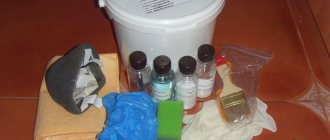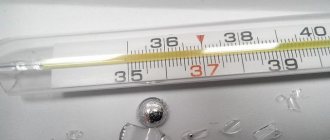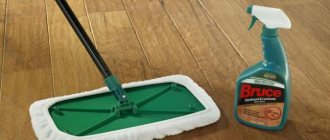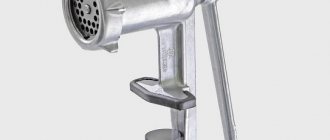Broken thermometer with mercury
Mercury is a heavy metal, the vapors of which are extremely dangerous for the respiratory system, central nervous system and other internal organs. The most common source of toxin in everyday life is broken medical thermometers. A glass device is considered more familiar and reliable than new electronic devices for measuring body temperature, so you need to know what to do if a mercury thermometer breaks.
Why is mercury from a thermometer dangerous?
The greatest danger is mercury vapor. The metal is absorbed by the lungs, quickly entering the blood and nervous system, which is sensitive to the negative effects of heavy metals. With a high concentration of mercury vapor, acute poisoning develops, which is manifested by pronounced neurological symptoms, dysfunction of the gastrointestinal tract, liver and kidneys. Possible consequences of acute intoxication:
- visual, speech and hearing impairments;
- memory impairment;
- severe headaches;
- disorders of muscle tone and coordination.
If fatal dosages are exceeded, the patient may fall into a coma and die.
Result of chronic intoxication:
- deterioration of concentration and memory;
- increased risk of developing diseases of the respiratory system (pneumonia, tuberculosis);
- damage to the liver, kidneys and gall bladder;
- atherosclerosis and arterial hypertension;
- In women, the menstrual cycle is often disrupted.
Mercury vapor poisoning during pregnancy can lead to miscarriage, premature birth, the development of chronic poisoning, cerebral palsy and underdevelopment of the fetal brain.
Room treatment and precautions
After cleaning, the room in which the mercury has scattered must be thoroughly washed. This can be done using a chlorine-containing liquid. It is necessary to wash the floor, baseboard and, if possible, walls with a chlorine solution. The chlorine solution must be left for 15-20 minutes, then rinsed off with clean water. For more information about cleaning principles, watch this video:
The room must be ventilated daily for 7-10 days. It is advisable to maintain a high temperature inside the room so that the remaining mercury can evaporate and leave the room. Ventilation is carried out with the door tightly closed to avoid drafts and movement of potentially dangerous air into other rooms.
You cannot stay in the room overnight until the preventive treatment is completed. A ball of mercury that rolls under a baseboard or into another hard-to-reach place can cause considerable harm to human health.
What to do if the thermometer breaks?
Despite the increased danger of mercury vapor, you should not panic if the thermometer is damaged and the substance gets on the floor and other surfaces in the living room. In compliance with safety regulations, you can collect mercury yourself and subsequently hand it over to the department of a special service for the disposal of mercury.
Algorithm of actions when breaking a mercury thermometer
What to do if a mercury thermometer breaks:
- Remove children, pregnant women, the elderly and people suffering from severe chronic pathologies of the kidneys, liver, nervous system and other internal organs from the room. Their shoes and clothing containing mercury should be placed in a plastic bag and disposed of.
- Close the door to the room where the mercury was spilled so that less air contaminated with harmful fumes enters other rooms.
- Open a window indoors. This will help ventilate the room faster, and in the cold season it will make it possible to reduce the rate of evaporation of the dangerous metal.
- Contain the location of the incident. Otherwise, the mercury balls may crumble into smaller ones and roll out on the surface during cleaning, and be carried to other rooms by shoes.
- Prepare a jar with a screw-on lid to collect mercury. The container must be glass or plastic. To prevent evaporation of the collected metal, it is necessary to fill the jar halfway with cold water.
- Before collecting mercury, you must put on personal protective equipment: plastic bags for shoes, rubber gloves and a mask covering your mouth and nose. To protect the respiratory tract, a regular disposable cotton-gauze mask, slightly moistened with water or a weak soda solution, is suitable.
- Collecting mercury should begin with large balls. Otherwise, under mechanical stress, they can break up and get clogged in the cracks between the parquet boards or under the baseboard. To collect large drops, you can use a rubber syringe with a thin tip or a syringe. It is convenient to collect small balls of metal using wet newspaper, tape or cotton wool moistened with water.
- Elimination of mercury from the scene of the incident should be carried out in the direction from the periphery to the place where the thermometer split. It is convenient to remove balls of the substance from cracks and recesses using a syringe with a thick needle. For a more thorough inspection, it is necessary to remove the baseboards or parquet.
- Every 15 minutes of cleaning, go out into the fresh air. When leaving a contaminated room, shoe covers should be removed.
- After finishing cleaning and thoroughly inspecting all surfaces where mercury could get in, close the jar tightly and place it out of the reach of children and heating appliances. It is prohibited to throw away a container with collected mercury: the can must be handed over to the services for the collection and disposal of high-risk waste (mercury lamps, batteries, thermometers, etc.) or to specialists from the Ministry of Emergency Situations.
If, when the thermometer splits, the substance gets on the carpet or carpet, the flooring will have to be thrown away, having first been packed in a plastic bag. It is impossible to completely remove small metal balls from a soft fleecy coating.
Clothing and other items that have come into contact with a toxic substance should be disposed of or at least thoroughly shaken out in cold air. If small balls get on furniture, you need to call a demercurization service for treatment.
After mechanical removal of mercury, you need to treat the contaminated room:
- Wipe the floor in the room with a saturated (dark brown) solution of potassium permanganate or bleach. Chemical treatment allows the metal to oxidize and significantly reduce the ability of mercury to evaporate. “Whiteness” diluted with water in a ratio of 1:8 is also suitable for cleaning the room. It is especially necessary to wash corners, cracks and other recesses in the floor.
- Leave the “Whiteness” solution on the floor for 15–30 minutes, tightly locking the door and window in the room. Then wash the floor with clean water.
- After 3-4 hours, re-treat all surfaces in the contaminated room with a 0.08% solution of potassium permanganate and wet clean the apartment. When cleaning other rooms, it is necessary to use other containers and rags.
- After repeated cleaning, ventilate the room where the thermometer broke. If possible, you should not enter the room for several days. All this time the window must remain open.
Gloves and other protective equipment that were used in collecting mercury and processing the room must be discarded, and shoes and exposed skin must be washed with soap and water and soda or a pink solution of potassium permanganate.
If the first solution used during cleaning is contaminated with mercury, it must be returned along with a can of collected metal.
Mercury on the carpet
The task of collecting mercury becomes significantly more difficult if the thermometer breaks on the carpet. It’s also good when the carpet has a fine pile and the balls are visible to the naked eye. In this case, it is enough to collect the metal particles with tape, a wet cotton pad or band-aid and throw them into a jar of water.
The situation is worse if mercury gets on a fluffy rug with long pile and the balls roll between the fibers. It is almost impossible to get them using the methods suggested above, so you will have to act differently:
- roll up the carpet, pulling the edges towards the middle;
- put the package in a plastic bag and take it outside, away from residential premises;
- Shake the carpet thoroughly and leave to air.
It is better if the rug hangs in the fresh air as long as possible. Only after 3-4 months will this product completely get rid of mercury dust and again become absolutely safe for human health.
What not to do?
Erroneous actions when collecting mercury can significantly complicate cleaning or contribute to the spread of the toxic substance in the apartment and neighboring rooms.
Prohibited actions when a mercury thermometer is broken
What should not be done if a mercury thermometer breaks:
- create a draft in the contaminated room before final cleaning;
- sweep metal balls with a broom or collect them with a vacuum cleaner;
- use a metal rather than a plastic bucket when cleaning;
- ignore the need to treat furniture, clothing and other household items that have been exposed to harmful substances;
- throw the broken thermometer and collected mercury into the garbage chute, waste tanks and sewers;
- wash items contaminated with toxic substances in a washing machine;
- wash and rinse rags used during cleaning in a sink or bathtub.
Using prohibited cleaning products (for example, a broom or vacuum cleaner) will lead to more active evaporation of metal and an increased risk of poisoning.
What can't you do?
There are several strict prohibitions that you need to know and follow when cleaning mercury from the floor. Otherwise, all the efforts spent on eliminating the consequences will be in vain, and the area of pollution will only increase.
- When ventilating the room, avoid drafts. Otherwise, mercury balls may scatter throughout the apartment.
- You should not remove mercury with a vacuum cleaner. Particles settled in the filters and on the inner surface of the corrugated hose will poison the air for a long time. After such cleaning, the vacuum cleaner will either have to be treated with special means or sent to a landfill.
- It is not advisable to collect toxic metal with a broom. The rods will break the bulky balls into smaller ones, and the area of infection will only increase.
- If toxic metal gets on the upholstery of upholstered furniture, rolls into folds and cannot be detected, you must call a special service for disposal of mercury waste.
- Do not use a washing machine to clean clothes in which mercury has been collected. It is better to throw away such textiles immediately.
Under no circumstances should mercury beads be flushed down the toilet. Metal lingering on the surface of sewer pipes will constantly poison the air in the room.
Symptoms of mercury poisoning with a broken thermometer
Symptoms of mercury poisoning
Signs of acute poisoning:
- headache;
- general weakness;
- sore throat when swallowing;
- loss of appetite, nausea, vomiting;
- pain in the abdomen, diarrhea (usually mucous feces, less often with blood);
- excessive secretion of saliva, swelling of the gums and bleeding from them;
- metallic taste on the tongue;
- chest pain, shortness of breath, cough;
- fever, chills.
Symptoms of acute intoxication appear within several hours after the substance enters the body. If, after contact with mercury, the temperature rises sharply and severe pain in the abdomen, head or throat occurs, you should immediately seek medical help.
Signs of chronic intoxication:
- fast fatiguability;
- weakness, apathy, drowsiness;
- chronic headaches;
- tendency to dizziness;
- excessive sweating, increased urge to urinate;
- deterioration of memory, ability for intellectual work and concentration;
- mental instability (anxiety, irritability, depression, uncertainty);
- impaired cardiac function, decreased blood pressure;
- trembling of fingers, lips, eyelids, and in severe cases - limbs (mercury tremor);
- decreased sensitivity of the skin, taste buds of the tongue (hypogeusia) and sense of smell (hyposmia);
- in some cases - enlargement of the thyroid gland.
Symptoms of chronic intoxication may appear over several weeks or months.
How to remove mercury from carpet and upholstered furniture
It is much more difficult to remove mercury from a sofa, carpet and other fleecy surfaces. To remove a toxic substance, you need to act as quickly as possible, preventing it from being absorbed into the fabric. The algorithm of actions is almost the same as in the first case. The easiest way to remove mercury from a sofa or carpet is with a piece of thick paper, but if the substance has already been absorbed into the fibers of the fabric, more thorough cleaning will be required using a stiff brush.
First aid and treatment
First aid measures for heavy metal poisoning include:
- removing the victim from the evaporation zone;
- rinsing the mouth and throat with a pale pink solution of potassium permanganate, taking it orally (no more than 500 ml);
- taking diuretics to accelerate metal excretion;
- inducing vomiting (with oral ingestion of mercury), if necessary, flushing the gastrointestinal tract, taking laxatives;
- hemodialysis (for insufficiency of kidney function).
Carbon sorbents (including activated carbon) are ineffective against heavy metal intoxication.
Penicillamine
For the treatment of acute and chronic intoxication, it is advisable to prescribe complexing drugs that bind mercury atoms:
- Unithiol (a universal remedy for heavy metal poisoning).
- D-penicillamine.
- Penicillamine.
- Succimer.
- Dimercaprol.
- Methionine.
- Taurin et al.
Treatment is recommended to relieve symptoms of intoxication due to inhalation of hazardous substances.
What to do after removing mercury?
As soon as the mercury is collected from the floor, you need to disinfect the accident site and think about your own safety. After all, even short-term contact with a toxic substance can cause unpleasant consequences.
- To clean the place where mercury has been spilled, you need to prepare a solution of 5 liters of water and 10 g of potassium permanganate and rinse the floors well.
- After this, the surface of the floor covering is treated with a soap-soda solution, which is prepared as follows: rub laundry soap, add water and stir until completely dissolved. Then add water to 10 liters, add 100 g of soda. This solution not only washes floors, but also cleans shoes and gloves.
- After cleaning, it would be a good idea to brush your teeth, rinse your mouth, drink activated charcoal, and take plenty of fluids the next day.
We recommend: Why can’t you connect copper wire directly to aluminum?
Neither a broken thermometer, nor collected mercury, nor things that were cleaned should be thrown into the trash. All this must be disposed of in a special way. Therefore, the easiest way is to call the SES and call a specialist or take the waste there yourself.
The thermometer should be stored in a closed medicine cabinet, out of the reach of children. If the thermometer accidentally falls out of your hands and breaks, you must carefully collect the mercury and take it to the SES for disposal. In difficult cases, when it was not possible to detect mercury balls, you need to call specialists to your home.
In what cases should you call specialists?
The Ministry of Emergency Situations on its official website gives detailed recommendations for the collection of mercury in residential premises. Immediately after the thermometer has broken, it is better to call the rescue service at 101 or 112 and consult with a representative of the Ministry of Emergency Situations on this issue.
Unfortunately, in Russia there is no well-functioning system for organizing the collection and disposal of mercury. In some cases, representatives of the SES and the Ministry of Emergency Situations do not even go to the scene of the incident, and give recommendations for collecting mercury over the phone. If employees refuse to respond to a call, contact a higher authority and ask for help. If you do not get a team to come out, collect the mercury yourself and take it to a radioactive waste collection point.
In megacities, there are often private companies that collect and dispose of the remains of broken thermometers and mercury. They also check the air for fumes. However, since these firms are private, you will have to pay to call a specialist.
How to treat a room
After collecting the bulk of the mercury, liquid metal molecules remain on the surfaces. There are several ways to neutralize small mercury particles:
- Pale pink solution of potassium permanganate.
- Detergent containing chlorine. You can buy chloramine at the pharmacy: the powder is diluted in water in a ratio of 1 kg of product per 10 liters of liquid.
- Alkaline solutions, for example, salt and acetic or citric acid. For every liter of water add a tablespoon of salt, a spoonful of vinegar or a pinch of citric acid.
- Soap and soda solution. Dissolve 40 g of grated laundry soap and 50 g of soda ash in 1 liter of water.
Potentially dangerous places are filled with solutions: cracks between floor boards, under baseboards and left for several hours. Then thoroughly wash the surfaces.
For professional cleaning, you can call demercurization specialists: they will determine the presence and level of mercury vapor in the air and neutralize toxic substances using special means.











